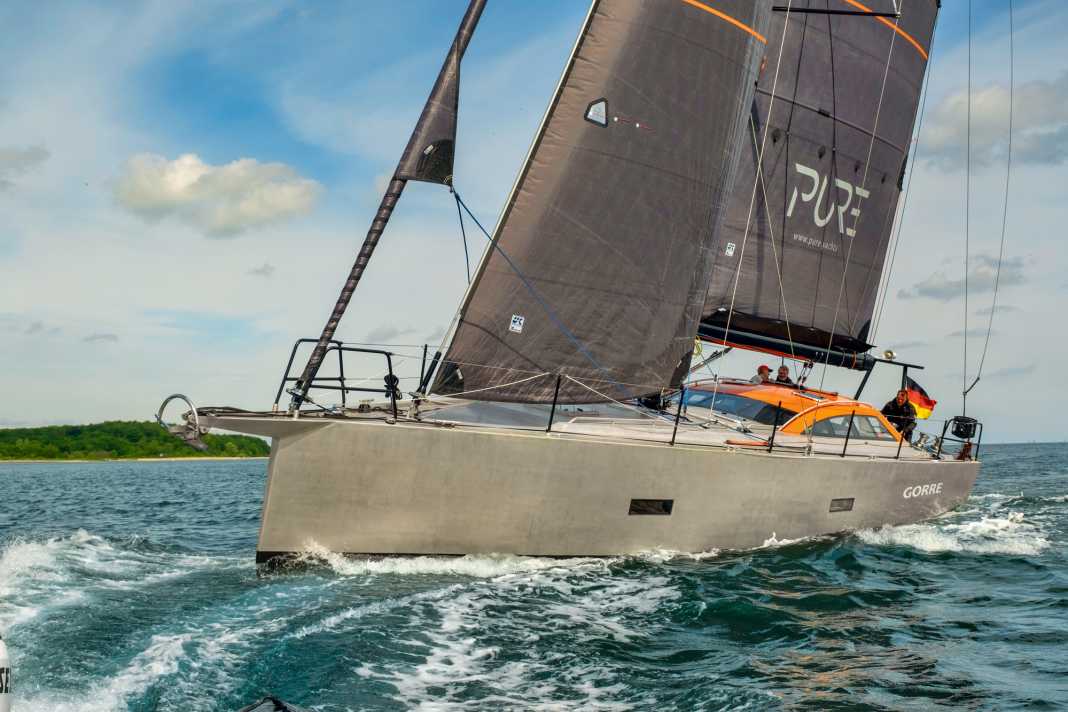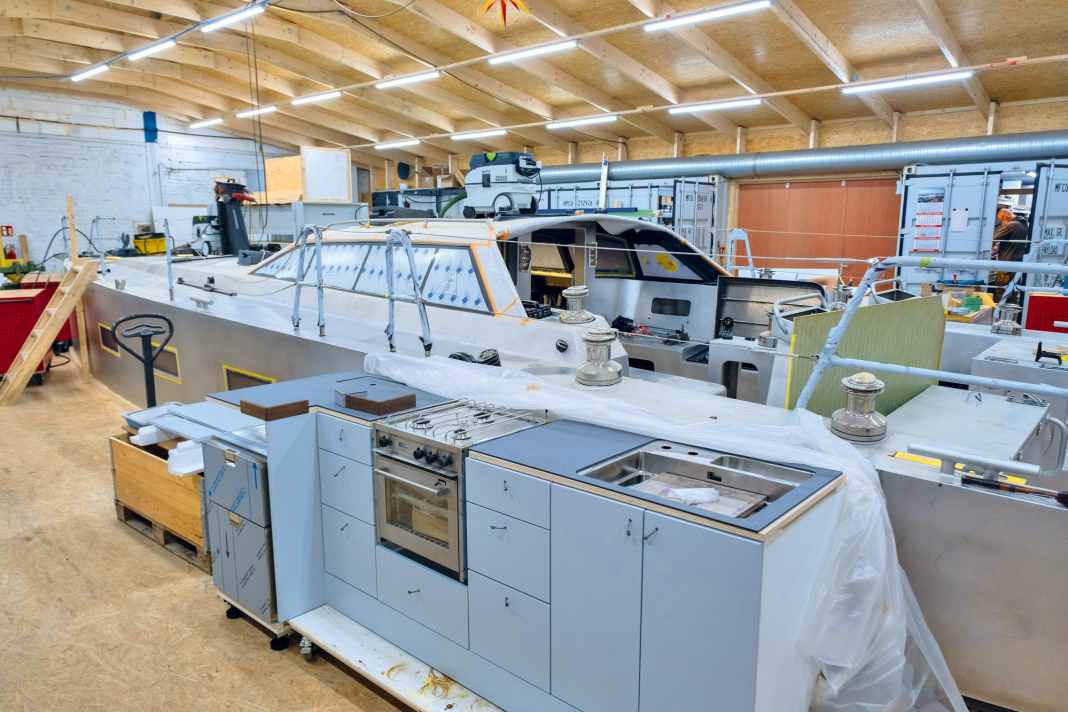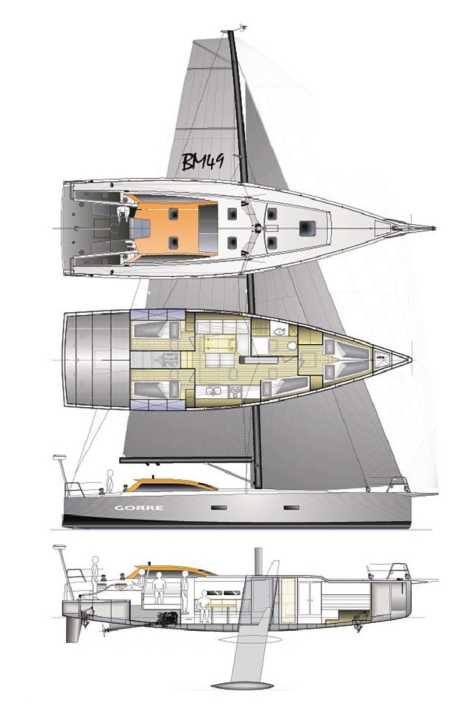





- A new player that fills a small gap: Pure Yachts
- The floor of the pilothouse is almost level with the cockpit
- The Pure 49 knows how to confirm its speed and stability on the water
- The Pure 49 seems ideal for long passages
- Boat also breathes practicality below deck
- Fast aluminium from the Sailing City
- Technical data of the Pure 49
If it were up to Helmut Schmidt, who famously once said: "If you have visions, you should see a doctor", Matthias Schernikau would need medical treatment. The former owner of a lift manufacturer certainly has visions and ideas for the future, namely on the subject of boatbuilding in Germany.
The 55-year-old wants to build a shipyard for upmarket and high-performance aluminium yachts in Kiel and sees this as a realistic opportunity due to the low level of competition and good demand.
Aluminium in Germany, wasn't there something? Flashback. In 1967, the chronicle of the North Sea island of Norderney records, among other things, the "foundation of the Norderney yacht building company Dübbel & Jesse at the harbour as a special shipyard for ships built in aluminium". The beginning of a great success story in local boatbuilding. Under the management of boatbuilders Uwe Dübbel (who had built the successful one-tonner "Optimist B") and Edwin Jesse, who were only 29 years old when the company was founded, world-renowned yachts, small series boats, one-offs and regatta yachts were built in the Wadden Sea in Lower Saxony.
Also interesting:
The latter date back to the golden era of yacht sailing, to the heyday of the International Offshore Rule, in times when the Admiral's Cup was regarded as the world championship of offshore sailing and the crews that were to be awarded one of the three coveted team places first had to be determined through elaborate elimination races in various areas. This involved hard training, fresh designs and new builds. In 1979, ten(!) new Cup-per were jostling for position on the starting lines off Helgoland and Kiel, six of which Dübbel & Jesse had assembled from aluminium alone. The German team was made up of the two light metal yachts "Jan Pott" and "Tina I-Punkt" as well as the moulded "Rubin VI". However, the three were unable to take silver as the storm of the century raged through the field of the Fastnet Race, claiming the lives of 19 sailors. "Jan Pott" capsized and lost her mast, "Tina I-Punkt" broke her rudder, only "Rubin VI" made it through.
Nevertheless, aluminium was at its peak in regatta sailing, but only until 1983, when sandwich construction began its triumphal march that continues to this day. Dübbel & Jesse continued to build famous products, Wilfried Erdmann's "Kathena nui", Clark Stede's "Asma", yachts for maritime history. This now includes Dübbel & Jesse itself, since the company closed its doors for good in 2003.
A new player that fills a small gap: Pure Yachts
Aluminium has remained a popular material for explorer yachts, long cruising yachts and large units due to its strength, toughness and relatively simple repair options. The market for large yachts is dominated by Huisman, explorers come from K&M, also in the Netherlands, plus Garcia and Allures as well as Ovni from France. Jachtbouw Folmer in Holland and Yachtwerft Benjamins in East Friesland specialise in hulls and one-offs.
And now a new player is stepping into a small gap: Pure Yachts and its performance explorers. Founder and co-owner Matthias Schernikau is thinking big. He has bought the former site of the Lindenau shipyard in Kiel and is setting up a state-of-the-art production facility, plans to build semi-series yachts and one-offs based on Berckemeyer Yacht Design designs, has already ordered five hulls from Folmer and is currently building a BM 50, with the possibility of building complete aluminium yachts at a later date.
The blueprint, first work and source of ideas was Schernikau's own project, his BM 49 "Gorre". He built it himself in five years from a Benjamins hull. An eye-catching boat, and not just because of the orange-coloured superstructure. The natural aluminium hull has vertical freeboards and a hard chine. The stern is open, the coamings high, the tiller steering rare for the size of the boat. Above the metal hull is a carbon mast, which is usually the other way round on performance boats: plastic hull with metal mast.
The room concept is as special as it is style-defining. It is a pilothouse boat. Designer Martin Menzner explains: "'Gorre' and the BM 50, which is currently under construction, both have a pilothouse. This means a cabin in which you sit in a sheltered position and have a 360-degree view of the world. There is no saloon or galley in a pilothouse. Both are located below deck. The pilothouse is ultimately just a protected extension of the cockpit." Menzner goes on to emphasise that in a pilot saloon and deck saloon, the saloon is elevated in the deckhouse. A pilot saloon is when you can see and steer 360 degrees while sitting in the saloon, even if this is only done using the autopilot remote control.
The floor of the pilothouse is almost level with the cockpit
On the BM 49 "Gorre", which shipyard boss Matthias Schernikau is integrating into his programme as the Pure 49, the pilothouse is designed as a fairly flat space for the free watch and is equipped with two benches. These are suitable for sleeping, for which flaps are opened in order to achieve a sufficient bunk length. The feet are then stuck in the head space of the rooms below the bunks. Sounds strange in the sense of odd, but it is not a novelty in yacht building. The floor of the pilothouse is almost level with the cockpit, and the saloon is accessed via the actual companionway.
The superstructure of the pilothouse accommodates the mainsheet traveller like a targa strap and thus keeps the cockpit nice and clear. The sheet is led aft like a German-Cupper system. However, through the terminal batteries on both sides of the companionway on two 52 Andersen winches. Spinlock's XTS Powerclutch models are used as stoppers, which are excellent for fiddling under load. Thanks to the tiller control, the two front winches and therefore also the important mainsheet control element are easy to reach and easy to operate. The headsail sheets are routed to two 62s, which are also easily accessible from the tiller.
The carbon rig from the Romanian manufacturer Axxon, which stands on deck due to the lifting keel, carries two upwind headsails as cutter rigging, a genoa and a heavy weather headsail aft on deck and offset down the mast in the style of a French trinquette, which is sheeted on a self-tacking rail. The three pairs of spreaders are swept back 23 degrees and allow the mast to do without a fixed backstay. For safety and trimming, there are double flying backstays, which are guided via 3:1 forerunners to a third pair of winches aft. They are attached to the masthead and the cutter stay. The strong sweep and the lack of an interfering backstay allow the use of a fathead mainsail, which offers more surface area and greater efficiency thanks to its geometry.
The Pure 49 knows how to confirm its speed and stability on the water
The deep lifting keel with bomb is also aimed at this. The fin can be lowered to a full 3.20 metres and locked in any position if required. Sailing is possible with the keel retracted, even in the shallowest position with a draught of 1.30 metres. The keel fin then protrudes from the deck in front of the mast, automatically opening a cover flap.
Two ballast water tanks are also welded in for greater stability and therefore performance. They extend over almost the entire freeboard height in the pilothouse area and hold 750 litres each. Menzner: "They are only installed for even more speed, not for more safety. They bring as much as ten men on the edge." The two turbos can be filled by back pressure or electrically and pumped into the new windward side by gravity before turning. High and flat, they do not stand out in the interior.
Even on paper, the Pure 49 with these components is a cracker. The ratio of sail area to weight is a dimensionless 4.9, which puts it on the cusp of being a racer. Or take stability: the keel weighs five tonnes, the ballast ratio is also quite high at 37 percent, and that's not even counting the large draught.
The "Gorre" confirms its speed and stability on the water. The boat is great fun. It starts with the tiller. The cranked tiller is 1.90 metres long and can be easily steered from the edge with an angled tiller boom. It is bevelled at an angle of around 20 degrees, making it a fabulous place to sit, even in a larger position. If this occurs despite the great stability, the twin rudders keep the boat on course and in check until the gennaker takes a bath.
The Pure 49 seems ideal for long passages
You will often be pulling it on this boat, as it is made easy for the crew. The sail can be set in its tube directly from the mast, where it doesn't even need to be packed. With a halyard winch on the mast - a welcome revitalised relic of earlier days - the distances are also short. The tackline on the welded bowsprit distances the sail far enough from the forestay for fast jibes. At half wind, we quickly see nine knots on the log without much effort. The size of the partially electrified Andersen pots and the overall layout are extremely user-friendly. The performance and also the steering behaviour are just right both upwind and downwind and are great fun. The helmsman only has to climb a little and find a quick way through the cockpit over the high thwarts and coamings; the cockpit seems to be geared towards its owner, who measures 1.95 metres.
Great: with the long tiller and boom, the boat can also be steered from further forward, where the roof of the pilothouse is extended to form a dodger. And if it gets really thick or wet: off into the pilothouse with the radio remote control of the autopilot, door closed, heating on. A long trip on this boat, with crew or alone? A dream. Urs Kohler, co-owner of Pure Yachts, will experience it, he has signed up for the Silverrudder. The boat seems ideal for long passages.
For such conditions, or even for trips to the high latitudes, one imagines a roaring stainless steel stove on the bulkhead, a certain degree of cosy design, an if not dignified, then at least inviting interior. Not the case. The interior of the "Gorre" matches its exterior: simple, cool, pragmatic. You don't have to like or accept this, aluminium yachts are semi-individual structures, the material allows for a largely free design and layout. A different interior layout, a completely different surface design, any special requests are possible, the aluminium construction method allows maximum freedom.
Boat also breathes practicality below deck
The "Gorre" is equipped with two cabins in the bow and stern. Another berth is provided by a peculiar box in the saloon between the galley and the foredeck, which has been fitted with a bunk. Instead of a second cabin in the stern, there is a huge walk-in locker to starboard. Technology such as heating and chargers are easily accessible there, tools are ready to hand, the control of the redundant water separator for the diesel is immediately visible and dirty fuel can be easily drained there.
The boat also breathes practicality below deck. There are no beautiful designer sockets from the top shelf of the yacht chandlery installed, but DIY market goods from the hobby cellar, and some of them are plastered. It doesn't cost much, is easy to replace and works. Drawers do not slide back into the furniture carcass on automatic pull-outs, but are pushed, snap into place and hold by gravity, that's it. Wall units in the galley or shelves in the saloon are not even installed, why lug around so much stuff? Matthias Schernikau is a craftsman, and he loves the straight and narrow. After all, this is his first boat and it was intended for him personally.
Other things were more important to Schernikau for the interior design. All components are easily accessible for maintenance and replacement. The longitudinal galley is easy to use, even when lying down, thanks to the double seat in the seating area. The engine can be reached from all sides, even from above. Sea valves sit on so-called standpipes, which end above the waterline and thus prevent water ingress if a valve is defective. Examples. Just like the welding work. You can see beautiful corners and curves on the outside, but also visually mangy internal weld seams on stringers and frames. Comparable to an unsealed laminate that is not covered by an inner shell.
This applies to the forecastle and sail load. In the living area, on the other hand, every centimetre of aluminium above the waterline is elaborately insulated with foam. All in all, a promising boat concept and a great business idea.
Perhaps Matthias Schernikau doesn't need to see a doctor after all.
Fast aluminium from the Sailing City




Matthias Schernikau is installing his newly founded shipbuilding company on the disused 12,500 square metre site of the former Lindenau shipyard in the Friedrichsort district of Kiel. In addition to direct access to the water, where up to 15 berths are to be created, halls with 3,600 square metres of space and a 60-tonne crane are available on the fjord. The halls are currently being extended and a state-of-the-art production facility for the manufacture and fitting out of aluminium yachts is being built.
High-end performance yachts in the 42 to 50-foot range are to be built there based on designs by Berckemeyer Yacht Design.
Pure is currently sourcing the hulls from Jachtbouw Folmer, but is considering producing them completely in-house. A Pure 50 is already under construction and a Pure 42 is offered in the Standard and Performance versions with more sail area thanks to a fathead mainsail. These yachts are deck saloon concepts, which means that the seating area in the saloon is raised and guarantees all-round visibility. Schernikau's own "Gorre" is the model for the Pure 49, a custom-built project that is also on offer. Also on board are master boat builder Urs Kohler, who worked at the Sirius shipyard for 18 years, and Ivars Linbergs, also a master craftsman and specialist in composite. Schernikau organises the construction of the shipyard and the work processes himself.
Technical data of the Pure 49

- Material: Aluminium/Alustar
- Torso length: 15,00 m
- Waterline length: 14,40 m
- Width: 4,30 m
- Draught/alternate: 1,30-3,20/2,60 m
- Weight: 13,50 m
- Ballast/proportion: 5,0 t/37 %
- Sail area a. W.: 136,0 m²
- Sail carrying capacity: 4,9
- machine (Yanmar): 56 HP

